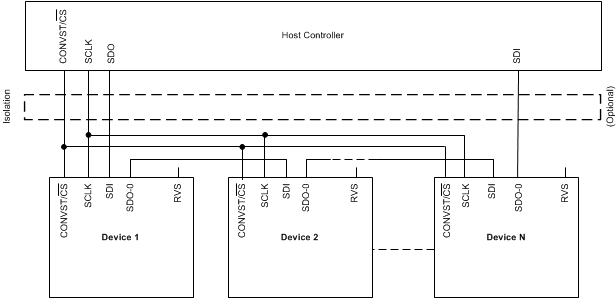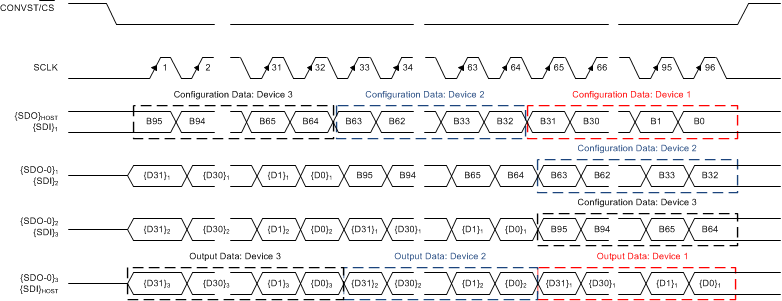SBASAY5 June 2024 ADS8681W
PRODUCTION DATA
- 1
- 1 Features
- 2 Applications
- 3 Description
- 4 Pin Configuration and Functions
- 5 Specifications
-
6 Detailed Description
- 6.1 Overview
- 6.2 Functional Block Diagram
- 6.3 Feature Description
- 6.4 Device Functional Modes
- 6.5 Programming
-
7 Register Maps
- 7.1
Device Configuration and Register Maps
- 7.1.1 DEVICE_ID_REG Register (address = 00h)
- 7.1.2 RST_PWRCTL_REG Register (address = 04h)
- 7.1.3 SDI_CTL_REG Register (address = 08h)
- 7.1.4 SDO_CTL_REG Register (address = 0Ch)
- 7.1.5 DATAOUT_CTL_REG Register (address = 10h)
- 7.1.6 RANGE_SEL_REG Register (address = 14h)
- 7.1.7 ALARM_REG Register (address = 20h)
- 7.1.8 ALARM_H_TH_REG Register (address = 24h)
- 7.1.9 ALARM_L_TH_REG Register (address = 28h)
- 7.1
Device Configuration and Register Maps
- 8 Application and Implementation
- 9 Device and Documentation Support
- 10Revision History
- 11Mechanical, Packaging, and Orderable Information
Package Options
Mechanical Data (Package|Pins)
- RUM|16
Thermal pad, mechanical data (Package|Pins)
- RUM|16
Orderable Information
6.4.1.3 Multiple Devices: Daisy-Chain Topology
Figure 6-21 shows a typical connection diagram with multiple devices in a daisy-chain topology.
 Figure 6-22 Daisy-Chain Connection Schematic
Figure 6-22 Daisy-Chain Connection SchematicThe CONVST/CS and SCLK inputs of all devices are connected together and controlled by a single CONVST/CS and SCLK pin of the host controller, respectively. The SDI input pin of the first device in the chain (device 1) is connected to the SDO-x pin of the host controller. The SDO-0 output pin of device 1 is connected to the SDI input pin of device 2, and so forth. The SDO-0 output pin of the last device in the chain (device N) is connected to the SDI pin of the host controller.
To operate multiple devices in a daisy-chain topology, the host controller programs the configuration registers in each device with identical values. The devices operate with a single SDO-0 output, using the external clock with any legacy, SPI-compatible protocols for data read and data write operations. In the SDO_CTL_REG register, program bits 7-0 to 00h.
All devices in the daisy-chain topology sample the analog input signals on the rising edge of the CONVST/CS signal. The data transfer frame starts with a falling edge of the same signal. At the launch edge of the SCLK signal, every device in the chain shifts out the MSB to the SDO-0 pin. On every SCLK capture edge, each daisy-chained device -shifts in data received on the SDI pin as the LSB bit of the unified shift register. Figure 6-19 provides a diagram of this process. Therefore, in a daisy-chain configuration, the host controller receives the data of device N, followed by the data of device N-1, and so forth. This process continues in MSB-first fashion. On the rising edge of the CONVST/CS signal, each device decodes the contents in the unified shift register and takes appropriate action.
For N devices connected in a daisy-chain topology, an optimal data transfer frame contains 32 × N SCLK capture edges (see Figure 6-23). Avoid shorter data transfer frames, which result in an erroneous device configuration. For data transfer frames with > 32 × N SCLK capture edges, the host controller appropriately aligns the configuration data for each device. The host then brings CONVST/CS high.
The overall throughput of the system is proportionally reduced with the number of devices connected in a daisy-chain topology.
Figure 6-23 shows a typical timing diagram for three devices connected in a daisy-chain topology and using the SPI-00-S protocol.
 Figure 6-23 Three Devices in Daisy-Chain Mode Timing Diagram
Figure 6-23 Three Devices in Daisy-Chain Mode Timing Diagram